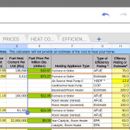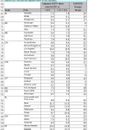Mini Split cost comparison to heating oil with New Englands expensive electricity
I am trying to compare heating oil cost against running 2 12k mini splits in CT. Electricity is really expensive here in CT at around almost .25kwh delivered. I do have a 5.4kwh solar array but would still need to purchase some power to run them through the winter. I have a forced air 90k carrier oil furnace that is ridiculously oversized for my 1600 sq ft house. I have been using this fuel cost calculator to run some numbers and it appears to be significantly cheaper to run the mini splits. One thing I am not sure is the accuracy of my HSPF number. I remember reading the HSPF number is for something like Atlanta. How would I convert my 2 mini splits to a number for New Haven CT? I have a gree sapphire 12k wall unit with a hspf of 15 and a midea console with a hspf 10.5. I sort of went with 13 to split the difference between my two splits to get a rough number but am guessing its much lower.
There is a hspf chart on the fuel cost comparison spreadsheet but it seems confusing. Do I assume Bridgeports number of 6.9? That seems really low.
GBA Detail Library
A collection of one thousand construction details organized by climate and house part











Replies
Check out:
https://ashp.neep.org/#!/product/25406
https://ashp.neep.org/#!/product/29986
If those are the correct units, you are probably looking at an average COP near 3 between the two. The Gree unit is much better espcieally at low temperature.
My guess it the operating costs will come out bellow oil especially in the shoulder season where the COP of the Midea unit is better. You should always run the Gree unit as much as possible, it definitely costs less than oil.
With the solar array, even if you have to purchase some power, going all electric is a no brainer.
Deleted
Its actually the below Midea unit. The plan is to establish a outdoor temp to switch over to oil. My numbers say its around 15-20 degrees. My oil furnace has a whole house humidifier that works amazing at keeping indoor humidity perfect. It really needs to run during polar vortex cold where the air is bone dry. My wife suffers bad from dry skin. I am estimating I may cut my oil usage down 80 percent or more. So far this month the savings have been noticeable. I am logging power consumption on both mini splits and have a very accurate ultrasonic oil gauge monitoring oil consumption. I have last year's oil usage to compare as well
https://ashp.neep.org/#!/product/30328.
With your historical data, you can determine exactly where the optimal switchover point is going to be. Keep an eye on energy consumption of your minisplits in relation to outdoor ambient temperature. You can determine where the crossover point is between electric and oil heat based on outdoor temperate using that data. Be sure to also track wind speeds. I’ve done this a bit at my own house (albeit for different purposes), and I’ve noticed that wind speed makes a big difference: higher wind speed results in lower thermal differential for the same energy input (less useful heating for the same input energy).
You may find that your optimal cutover point occurs at a higher outdoor temperature when there is more wind. Note that this will be due to more heat loss from your house and not so much that the heat pump isn’t as effective. The heat pump will just have to run more with higher winds to keep your house at the same temperature.
Bill
I have not done the math but my guess is in CT you have enough hours below 5° that you want a mini split with HYPERHEAT. It works better when it is cold outside more or less it compresses some of the refrigerant twice so it can work at lower temps.
Something like this one may carry the load to below -10.
https://ashp.neep.org/#!/product/25949
Walta
I was able to do one pseudo scientific test a few years ago in the shoulder season which compared my mitsubishi low temp heat pumps against my 90- percent oil boiler.
It was not completely scientific because I obviously I cannot compare straight up and the SO would not let me continue until it got actually cold
The results were....ehh
It would not have been so wildly cheap to run mini splits that it was worth any downsides
But.........an oil boiler requires yearly maintenance and has a lifespan and replacement cost. Oil price varies by day, so it might be cheaper to run oil today but not next week.
Where I would find a dual system useful is if the mini splits started to lose capacity when it got very cold. If I was using say, less than 100 gallons of heating oil a year I personally would be comfortable going several years without maintenance on the oil furnace.
At the end of the day, if I had known what I know now and had access to the products that are available now 10 years ago, I would not have spent 14 grand on a boiler, and would have run all mini splits with a separate water heater, and i am sure that the mini splits, if they were less efficient would have cost me less than the boiler did.
i think in your situation I would run a season with mini split only and see how they perform in cost and effectiveness. If you are happy with both you then know that if the furnace dies, you do not need it.
Some rough numbers for November. I pretty much left both splits on nonstop. There were a few times I ran the oil furnace but according to my ultrasonic oil gauge I only used 6 gallons of oil.
Both mini splits consumed 448 kwhs. I have solar panels and net metering but if I had to purchase the power at .20 kwh it would have cost me 89.60.
Here is the daily usage combined for the month of Nov. I have a 12k gree sapphire wall mount on the first floor and midea 12k floor console on the second.
In just ran the numbers for Dec. Both my mini splits combined used 510 kwhs. I have a ultrasonic wifi heating oil gauge and the year over year oil savings are quite clear from the attached graph.
According to my data if I had to purchase all the electricity to run my mini splits it would cost half of what oil would. I have solar panels so I am purchasing little to no electricity.